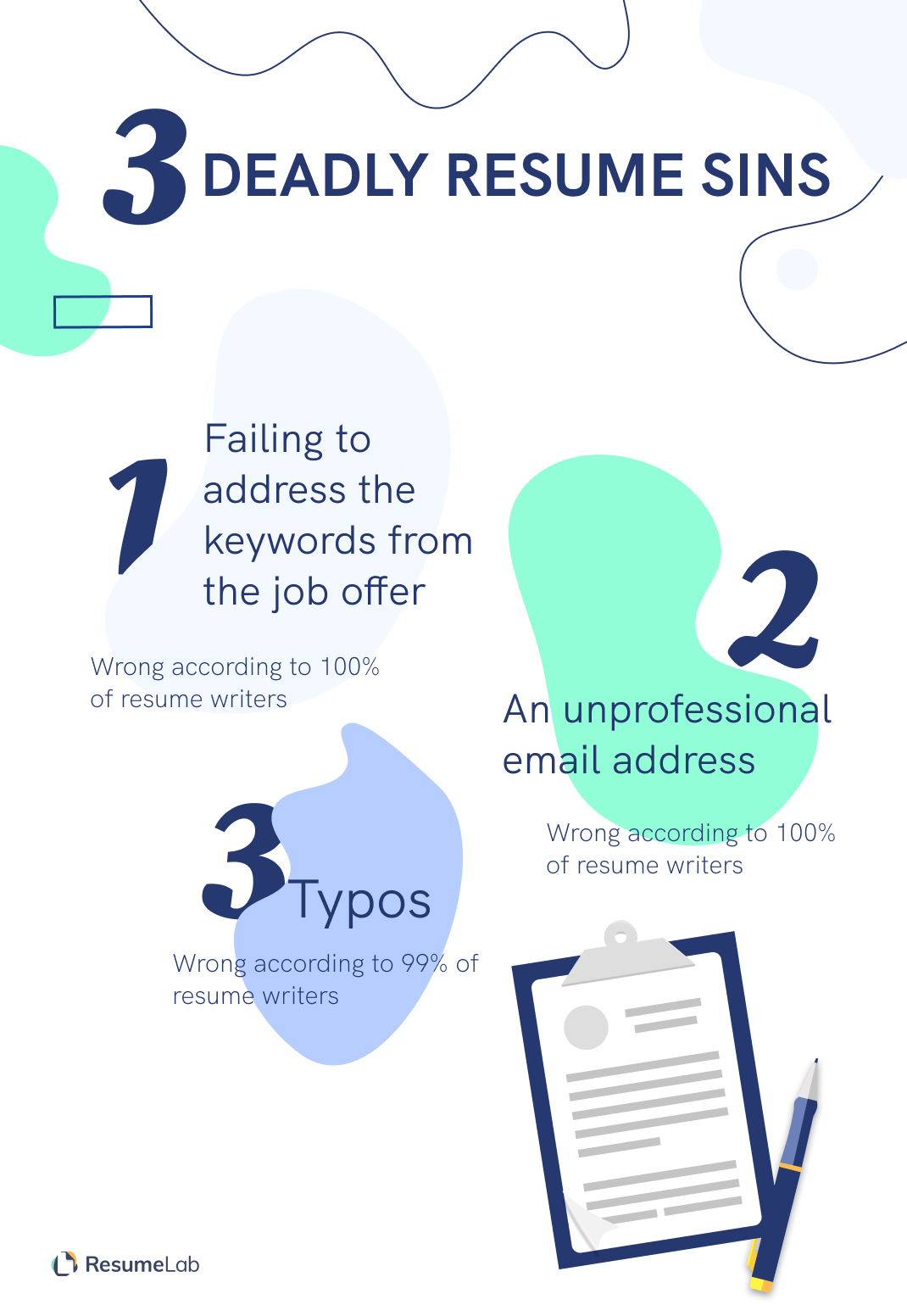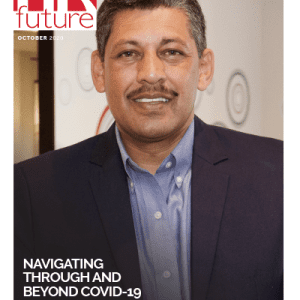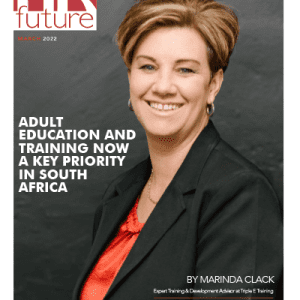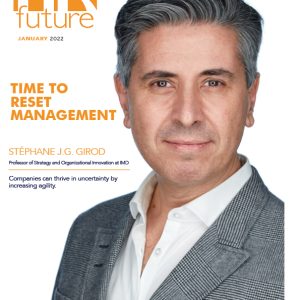When writing a resume, it’s easy to forget about some important details or include something you’re not supposed to. But that won’t happen to you ever again—if you read this study.
According to Jobvite’s 2019 report, whenever you submit a resume in an online job application, you have less than 2% chances of being offered a job. Amidst the coronavirus crisis and the current economic breakdown, this number will be much lower by the end of 2020.
Writing a resume is a scary thing. One lapse can cost you a shot at the gig you’ve been seeking for months. Or so you’ve been told. It can’t be that bad, can it? Truth is, while there is some margin for error in resumes, there also exist certain job-killing mistakes.
The good news? Spend 5 minutes reading our study and you’ll never make one again. To discover everything there is to know about the worst resume slip-ups, we surveyed 100 Certified Professional Resume Writers (CPRW). And now we’re sharing with you what we learned from them.
Let’s get started:
The Three Deadly Resume Sins

Yes, there are many mistakes you can make on a resume. But there are three unequivocally worse than any others—three that virtually all of our respondents agreed on.
#1: Failing to address the keywords from the job offer (wrong according to 100% of resume writers)
Please, please, keep this piece of advice in mind forever—
Every resume you send out has to be personalized to match the requirements of the job you’re applying for. It’s no rocket science. In fact, you have a very clear blueprint of keywords to include in a given resume: the job offer itself!
Why is it so important? First of all, most large companies nowadays use Applicant Tracking Software (ATS) to scan resumes before those reach a human decision-maker. ATS is programmed to search for relevant keywords on a resume. If it can’t find those on yours, you’re not getting a pass, simple as that.
Plus, on a resume, you have to show you’re the right candidate for *this* role—it’s actually impossible to do so without addressing keywords related to required skills or areas of expertise.
Sadly, very few candidates actually write personalized resumes for every job application. Zety’s study on 133,000 resumes made with their resume builder revealed than an average user makes less than 2 resumes per job search (1.73 to be precise)—most users apply with a single, all-purpose resume to all job opportunities and it’s clearly the wrong strategy. A Careerbuilder study showed that 63% of recruiters want to receive personalized job applications.
#1 (equal first): Having an unprofessional email address (wrong according to 100% of resume writers)
It really is simple:
In the professional world, the only items your email address can contain are:
- Your names
- Your initials
- Digits.
[email protected]? That’ll do the trick.
[email protected]? That won’t.
Also, make sure not to use your current work email: it looks unprofessional and makes your integrity questionable.
#3: Typos (wrong according to 99% of resume writers)
This one’s fairly obvious. As one of our respondents said, “proofread [your resume] as many times as necessary.” This means: check and double-check and check again until you’re sure there aren’t any typos or other errors left. Or use Grammarly or any other spell-checking tool. You might want to ask a friend to proofread your resume, too.
A random typo happpens to all of us but it should never be the case on a document you’re supposed to craft so carefully.
Now that we’ve got the three gravest (if obvious) resume mistakes out of the way, let’s look into some more sophisticated aspects of resume writing and examine what can go wrong.
Job-Killing Resume Mistakes You Didn’t Know Were So Bad

#4: Omitting your LinkedIn profile (wrong according to 96% of resume writers)
A recent report by Careerbuilder revealed that 2 in 5 recruiters won’t even consider calling you in for an interview if they can’t find you online. LinkedIn is where they’ll start searching (if they bother to search at all). Make it easier for them to identify your “professional footprint” online—put your LinkedIn URL in the contact information section of a resume.
#5: Skipping the skills section (wrong according to 95% of resume writers)
Skills are what makes you good at your job. Be upfront about them! Including a well-designed skills section on a resume does two things:
- Lets recruiters see you as an ideal candidate in a flash.
- Helps your resume pass the ATS scan.
See—
The most important resume keywords concern your skills. Make sure they’re visible in a flash.
Finally, 75% of US recruiters think the biggest issue in finding the right candidates is… the lack of job-relevant skills on the market.
#6: Adding a list of hobbies if you have more than 5 years of experience (wrong according to 90% of resume writers)
When working on your resume, keep this in mind: every single word has to earn its place on the page. Skip whatever feels redundant. Only include details that add value.
Whenever you’re putting anything on a resume, ask yourself the question: is this phrase or item showing that I am *the* best candidate for this position? If the answer’s no, feel free to delete it.
A list of hobbies and interests might add a “personal touch”, but you’re not going to get hired because you’re likable. Let your expertise do the talking.
#7: Including a list of references with their contact details (wrong according to 89% of resume writers)
A no-no for two main reasons: first, it’s against most personal data protection laws, secondly, it’s definitely against resume etiquette. And playing the resume game is all about following some well-established rules.
#8: Including your GPA if you have more than 5 years of experience (wrong according to 89% of resume writers)
If you have a solid work history behind you, no one will really care about how you did in school. Remember what I said about relevance? It’s the bread and butter of a professional resume. A GPA is just not relevant—your work experience should do the talking.
But (and it’s a huge but), here’s the twist:
#9: Skipping your GPA if you’re a student (wrong according to 88% of resume writers)
If you’re a student or a fresh graduate, do include the GPA: it’s the most measurable metric to prove how successful you were in your most recent professional endeavors.
According to 88% of our respondents, adding a GPA to a resume by students and candidates with less than a year of experience is desirable.
As for candidates with 1–5 years in the workforce? That’s a bit of a judgment call. 59% of resume writers think adding a GPA by such candidates is okay.
Alright, you think a GPA on a resume would benefit you… But what number, exactly, to include?
- 75% of respondents say you should use the exact number from your diploma.
- 16% suggest you truncate it.
- 8% say round it up.
- 1% say round it down.
The worst thing you can do? List a fabricated GPA. (Which is my roundabout way of saying “DON’T LIE ON A RESUME,” a mistake so obvious, we won’t even put in on the list).
The single worst resume mistake one can make is lie. Don’t stretch the truth. Don’t fabricate. It will get found out, and it will kill your credibility.
#10: Skipping the resume profile or summary (wrong according to 87% of resume writers)
According to the famous 2018 Eye-Tracking Study by The Ladders, recruiters focus most of their attention on the top third of a resume: this is exactly where your resume profile should grab their attention.
Some candidates choose to skip this part because they wrongly conflate resume “profile” with an old-school “career objective,” i.e. “Looking for a challenging role where I can grow my skills.” No one wants the latter, but a well-phrased resume profile will let you show prospective employers the value you bring to the table in a flash.
The biggest mistake that I often see in a resume is using an objective instead of a professional summary. Objectives should not be used in a resume. Your objective is to find a job, but your professional summary should outline who you are as a professional and the high-caliber skill sets you have to offer.
#11: Stuffing your resume with keywords from the job offer (wrong according to 86% of resume writers)
Wait, how come? Not using keywords from the job offer has been listed as the gravest resume mistake ever. Well—there’s using resume keywords strategically and then there’s randomly spraying them all over the page.
Imagine a job ad calling for someone to:
- Ensure necessary reporting and cross-regional leverage takes place.
- Run project team meetings to drive completion of tasks.
- Create, and update timelines, develop risk management, status reporting and manage cross-functional interfaces.
This is what “keyword stuffing” a resume would look like:
Project Manager
XYZ Company
2018–Present
- Ensured necessary reporting.
- Ran project meetings to drive the timely completion of tasks.
- Created and updated timelines, supervised risk management, coordinated cross-functional interfaces.
You get it, right? Optimizing resume keywords for ATS performance isn’t equal to copypasta.
#12: A resume longer than a page if you have less than 5 years of experience (wrong according to 82% of resume writers)
If you have between 5 and 10 years of experience, 50% of resume writers say it’s fine for you to have a resume longer than a page. A seasoned pro with 10+ years of work history? 74% of our respondents suggested you write at least a two-page resume. For those of you just starting out on a professional path, stick to the good ‘ol single pager.
#13: Failing to use industry-specific jargon (wrong according to 75% of resume writers)
According to Stephanie Renk, CPRW, “the worst thing you can do is to not focus your resume on the type of job or the industry you are applying for.”
This means that your resume has to show you’re familiar with the industry buzzwords and can use a professional lingo.
If you’re an online marketing specialist, you’re expected to talk about ROI, CAC, LTV, ad spend, and CTR. If you’re a nurse, you can and should touch upon phlebotomy skills, EMR, and BLS.
#14: Adding quotes (wrong according to 73% of resume writers)
Some job seekers use inspirational quotes on their resumes.
I mean, just imagine this:
Jane Doe
Project Manager
202-555-0120
“The only place where success comes before work is a dictionary.”
Cringe overload, right?
One client I worked with opened her resume with a quote from her reference. Neither approach makes sense. Your achievements, skills, and credentials should do the talking. A resume is no place for a narrative.
Resume “Mistakes” Some of You Might Pull Off
There are three more resume mistakes most candidates should avoid—at least when applying for a “standard” corporate job. But—
Some might actually make a resume like that and make it work. (Hint: I’m mostly talking to creative types applying for relaxed, semi-formal positions in tech, graphic design or modern digital marketing).
Here are the not-so-universal resume mistakes:
#15: Writing a “creative” resume (wrong according to 83% of resume writers)
The key downside of creative resumes is that they’ll never make it through standard ATS programmed to identify text layers only.
Every individual and situation is unique, so resume strategy must also be unique and flexible. For example, someone in a creative field could opt for a visual or graphic-based resume (as long, I can’t stress it enough, as it’s ATS compatible).
Plus, according to a study published in The European Journal of Work and Organizational Psychology, hiring pros are most fond of standard resume layouts and formal designs.
Trying to be too creative or stand out no matter what can lead to too many mistakes and will most likely either give a recruiter a good laugh or irritate them.
#16: Adding social media handles (wrong according to 81% of resume writers)
LinkedIn is the only commonly-accepted social network to link to on a resume. But it doesn’t mean you should never add other social handles, as long as those are relevant to your professional activity:
- Working in graphic design, photography, or other visual fields? If you store your portfolio on Instagram, Pinterest, or Tumblr, do include a link.
- Are you a Twitter influencer, posting about novelties in your industry? You know the drill, link to your Twitter account.
- A prolific coder? Link to Github.
#17: Applying with a video resume (wrong according to 80% of resume writers).
Like I said, getting overly creative can, and usually will, backfire. Video resumes are particularly risky—if you’re not a savvy video editor, you’ll end up looking ridiculous and, possibly, become a meme in your target company. Plus, the only way anyone will notice your resume is when you apply directly to the hiring manager—no online application form supports video files.
Still feel like using a creative resume or a video-based one can help you stand out? I’m keeping my fingers crossed for you. But remember: you have been warned.
Thoughts?
As a quick recap, see these two excerpts from resumes. How many typical resume mistakes can you spot on the wrong one?

If, in the past, you’ve made some of the errors we’ve just covered, well, hate to break it to you, but they might have cost you a shot at some of the jobs you wanted. So do make sure not to repeat them ever again.
Let us know in the comments if you find anything surprising or unclear. Remember—resumes are highly individualized so there’s no magic formula. The mistakes we listed are just rough guidelines to help you create a resume in line with modern hiring practices.
Methodology and Limitations
For this study, we surveyed 97 Certified Professional Résumé Writers (CPRW) who obtained their certifications from The Professional Association of Résumé Writers & Career Coaches™. 64 of the respondents were female, 33 were male. 4 respondents were 24 or younger, 36 were 25–38 years old, 49 were 39–58, and 8 were 59 or older.
In the survey, we asked 5 close-ended questions, 3 open-ended questions, and 16 scale-based questions regarding the perception of various resume practices.
The data rely on online self-reports after eligibility screening. Each participant responded without any researcher administration or interference. Potential issues with self-reported data include but are not limited to exaggeration, selective memory, and attribution errors. Some questions and responses have been rephrased for clarity and ease of understanding for readers. In some cases, the percentages presented may not add up to 100 percent: this is either due to rounding or due to responses of “neither/other/don’t know” not being presented.
Sources
- https://www.jobvite.com/lp/2019-jobvite-recruiting-benchmark-report/
- https://doi.org/10.1080/13594320902903613
- https://www.capterra.com/recruiting-software/impact-of-recruiting-software-on-businesses
- https://www.g2.com/categories/applicant-tracking-systems-ats
- https://zety.com/blog/resume-statistics
- http://go.theladders.com/rs/539-NBG-120/images/EyeTracking-Study.pdf
- https://www.talent-works.com/2017/09/27/social-media-recruitment/
- https://www.shrm.org/hr-today/trends-and-forecasting/research-and-surveys/pages/skills-gap-2019.aspx
Fair Use Statement
Feel free to share our study! The graphics and content found here are available for noncommercial reuse. Just make sure to link back to this page to give the author proper credit.


























